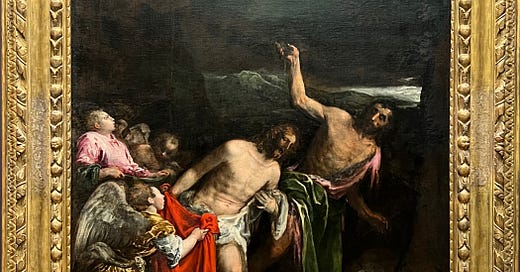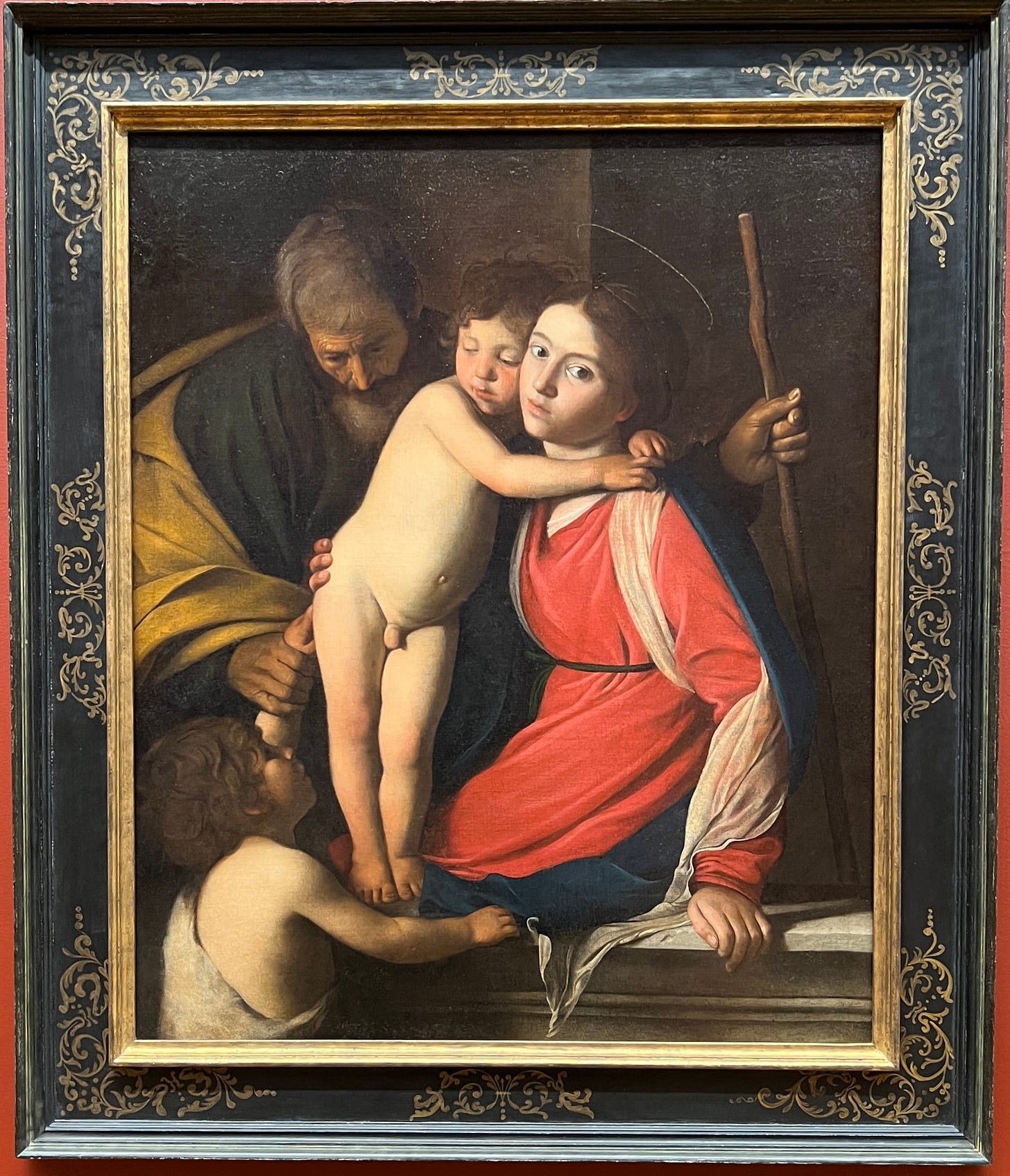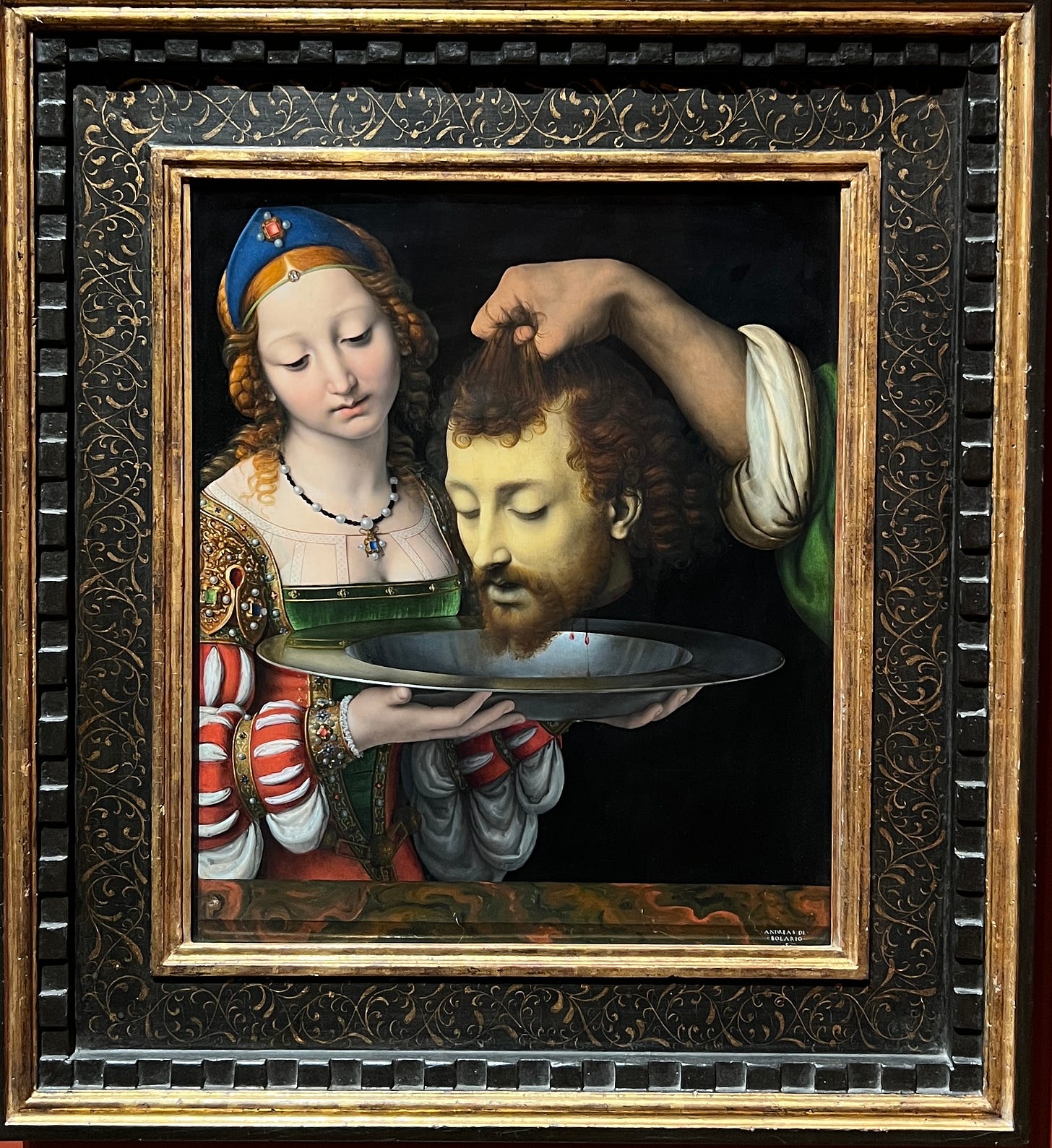After so many years under wraps for infrastructure upgrades, The Met’s European galleries were beckoning. Oops… It looks like they lost their aesthetes in the interim and replaced them with pedagogues. Despite the wonderful collection, there isn’t a visually powerful room left, by comparison to previous installations. Oh well. On the bright side, some gripping curiosities were dusted off for the occasion.
Unfinished at Jacopo Bassano’s death, touchingly, The Baptism of Christ was left that way by his painter sons, of which he had four, who might have done well to finish the famous artist’s last work and put it up for sale. Instead, it was kept in the family untouched for a century. The background has a deep, unorthodox gloom, as if John were baptising Jesus in the dead of night. The label suggests that Bassano may have opted for a nocturnal baptism to foreshadow Christ’s Passion, the series of tragic events that culminates in the ultimate sacrifice. It’s an elegant explanation.
The baptism is symbolic of Christ’s submission to the will of God, his father, and to “fulfill all righteousness” by submitting to his all-too-human fate. The event is usually shown taking place during the day, however, which may have also been Bassano’s intention. He is known to have looked carefully at brushy late Titian and, like him, to have preferred a dark ground in the latter half of his career. This sometimes gives his later works a resemblance to painting on velvet, especially in the exaggerated versions of his copyists or in his sons’ immitations. Conceivably, Bassano just didn’t get around to brushing in some blue before his decline. A somber token of arbitrary endings, it is a witness to a family’s grief at the loss of a brilliant father.
Christ is usually shown either bowing his head slightly or, in the early Renaissance, standing up straight as a kouros under John’s pouring hand, the way Giotto and Piero della Francesca portray him. But Bassano’s Christ looks like he is about to take a knee, almost destabilising John who leans sideways to stay in position. His baptising hand rises toward the Holy Spirit who lines up above in time to ratify the sacrament. This is also the moment when God reveals that Jesus is his son; the heavenly voice startles the attendants.
Those twinned diagonal torsos, dynamic and strange, are a foretaste of the impending Baroque with its novel poses and high drama. And there’s a snapshot spontaneity to the awkward composition with its flashbulb lighting. This picture was a consoling surprise.
Have you ever seen a younger Mary? She’s a child to my eyes, shockingly young for a mother. Renaissance idealism was long ago in this Baroque picture. We are at the height of the Counter-Reformation, the Catholic culture wars—and a futile, bloody struggle it was—against encroaching Protestantism. The artist understands his mission and his gloves are off. Highly naturalistic, this interpretation of the familiar scene—the meeting is a stock subject in art but does not occur in the Bible—resembles him. Still as moving today as it must have been four centuries ago, the picture has charisma.
There’s an uncanny realism to the animal bond between these children, mother and son. Are they aware of their fate? The infant Jesus looks down at the infant John, his mother’s relative, with mild apprehension. Saint Joseph holds the little visitor’s hand up to Christ’s thigh as if teaching the boys to play tag: “You’re it, Jesus.”
Christ shifts his hip to oblige the tiny finger, obliquely reminding me of Michelangelo’s Creation of Adam, of doubting Thomas’ evidence-gathering touch, and of the risen Christ’s “touch me not” to Mary Magdalene. Accommodating John, Jesus still clings to his mother for safety.
Like Enkidu in the Epic of Gilgamesh, John hails from the wild, symbolised by the rough hide he is always shown wearing. I am fascinated by this New Testament echo of a story written two thousand years earlier: fraternal devotion between antithetical archetypes, the primitive and the noble, the pitiable ascetic and the god-like figure of universal authority. Were such tales intended to establish the virtue of leaders? I would love to hear Joseph Campbell and David Graeber on the subject, but alas…
As his precursor in ministry, John will one day baptise Jesus, launching him into a life of preaching that will end in capital punishment for both of them. And both had been miracle births: one to post-menopausal Elizabeth and the other to the inviolate child that the artist depicts as Mary. As for the wizened man with the staff in the background, gathering the family protectively, he is Joseph, God’s paternal proxy, typically shown in shadow with eyes averted and head bowed before his miraculous wife and her divine son.
The holy infant’s nakedness is the point of this painting: blunt proof of the saviour-god’s humanity. That, and the pathos of the child-mother who seems to know already how their story will end as she acknowledges our pity.
This picture is as sophisticated as propaganda gets. I’m happy to agree with The Met that only Caravaggio could have painted it, but not everyone is convinced.
John the Baptist’s relationship to Christianity is like Tom Thomson’s relationship to Canada’s Group of Seven. His death predates the founding but he is key to both the genesis and the spirit of the cult. All three synoptic Gospels tell his story,—Matthew, Mark, and Luke, (John the Evangelist’s Gospel is of another nature)—describing him as the precursor to Jesus whom he predeceases. Solario’s picture sums up the grizzly martyrdom.
Herodias married her husband’s brother, Herod Antipas, while her first husband was still living. Parenthetically, both men were also her uncles. John the Baptist protested the illegitimate marriage publicly. To shut him up and defend his new wife’s honour, Herod had the preacher locked up in the cistern, a witty place to send a firebrand immerser to cool off. At Herod’s subsequent birthday party, his stepdaughter Salome—also his niece and grandniece—danced so beguilingly that the tetrarch impulsively promised her anything she wanted in return. After consulting with her vengeful mother Herodias, Salome requested John’s head on a platter. Herod, horrified at the thought of killing a holy man, relented to save face before a houseful of witnesses to the promise.
A consequence of this incident is the expression “head-on-a-platter,” a cliché of office intrigues and political theater. And many works in every medium were born of the sordid story. My favourite is Richard Strauss’ opera Salome, with libretto by Oscar Wilde, an erotic nightmare of heroic sourness.
Mandaeans believe that John the Baptist is the Messiah, not Jesus, his initiate and fellow prophet. There are fewer than 100K descendants left of this long-beleaguered semitic people, the last surviving Gnostics. Contemporaries of the first Christians, like many of them, including Jesus, the Gnostics spoke a dialect of Aramaic. By then, Hebrew had become a scriptural language, as similarly expired Latin would later become for Catholics. Modern Hebrew is a late 19th century revival of an archaic tongue that was no longer spoken by the Jews of the New Testament.
Cultural flux and hybridity are also stylistic features of this chilling picture, a cocktail of influences from Netherlandish hyper-detailing; the Venetian emphasis on colour—Naples yellow at its most nauseating; and the softness of Leonardo da Vinci, whom Solario assisted when the Florentine lived in cosmopolitan Milan.
Artistic styles, like languages and symbols, are fluid and vulnerable to outside influence and to the vicissitudes of history. They are in a constant state of metamorphosis, as is the meaning, interpretation, and sanctity of even the most indelible stories and unforgettable people, such as John the Baptist, patron saint of my fellow French Canadians.
Why the early French settlers to North America would have chosen the “wilderness prophet” may have something to do with the illusion that they too were living in a wilderness, though it was no such thing to their Indigenous neighbours who had roamed it for thousands of years. ‘Wilderness’ is a word, like ‘discovery,’ that begs retirement in connection to the European presence in the Americas, not only as an overdue gesture of decolonisation, but because the concept contravenes our survival. There is no virgin wilderness on a balding planet saturated with microplastics. We need urgently to stop pretending.
Saint John the Baptist’s feast day of June 24 was for centuries an important festival in the French calendar, a celebration that the early French settlers brought with them to the “New World.” Coincidently, Herod Antipas and Herodias were exiled to Gaul, modern day France, when the Romans tired of them. They are unlikely to have imported a festival dedicated to the man they beheaded back home, but his legend must have traveled with them in their luggage.
“Decapitation” is a synonym of beheading. In fact, it’s the French translation of the word and has special resonance in Québec. The removal of the French colonial elite by the British after the conquest of 1759 is conventionally referred to metaphorically as a “decapitation.” The word is similarly used in reference to the exiled leadership of the “Patriotes,” the French half of the larger national uprising against the “Family Compact,” the monopolising elite installed by imperial Britain. Although it failed, Canada’s Rebellion of 1837 and its unresolved grievances set the stage for the administrative autonomy that was established thirty years later by Confederation.
La Saint-Jean is the biggest party of the year in Québec, which is curious given that it commemorates a Jewish ascetic. It is to Quebeckers what St. Patrick’s Day is to the Irish. The Feast of Saint John is a christianisation of the pagan celebration of the summer solstice, the year’s longest day of sunlight. But when journalist and devout nationalist Ludger Duvernay founded the Société Saint-Jean Baptiste in 1834 to advocate for the language, culture and rights of the French under British rule, the secularising process had begun. Soon after the sovereigntist Parti Québecois came to power in 1976, Saint John’s celebration was ‘sacrificed’ to create the Fête nationale du Québec and the metamorphosis was complete. Residually, Québec’s national holiday is still commonly known as “La Saint-Jean,” despite having lost its religious vocation. The feminine article “la” is used because fête (festival) is a feminine noun. Conveniently, the article distinguishes la fête from le saint without having to elaborate.
At the risk of abusing the intention of Antoine Lavoisier who “discovered” oxygen, the last lungfull of which he took beneath a decapitating guillotine, immaterial culture too is subject to time and to the principle that “nothing is lost, nothing is gained, everything is transformed.” This scientific observation notwithstanding, a great art collection like The Met’s can stop time. Even when they are rearranged with less felicity than they had been in the past, such relics of human mutability will always be holy to me.







Best final paragraph ever written.